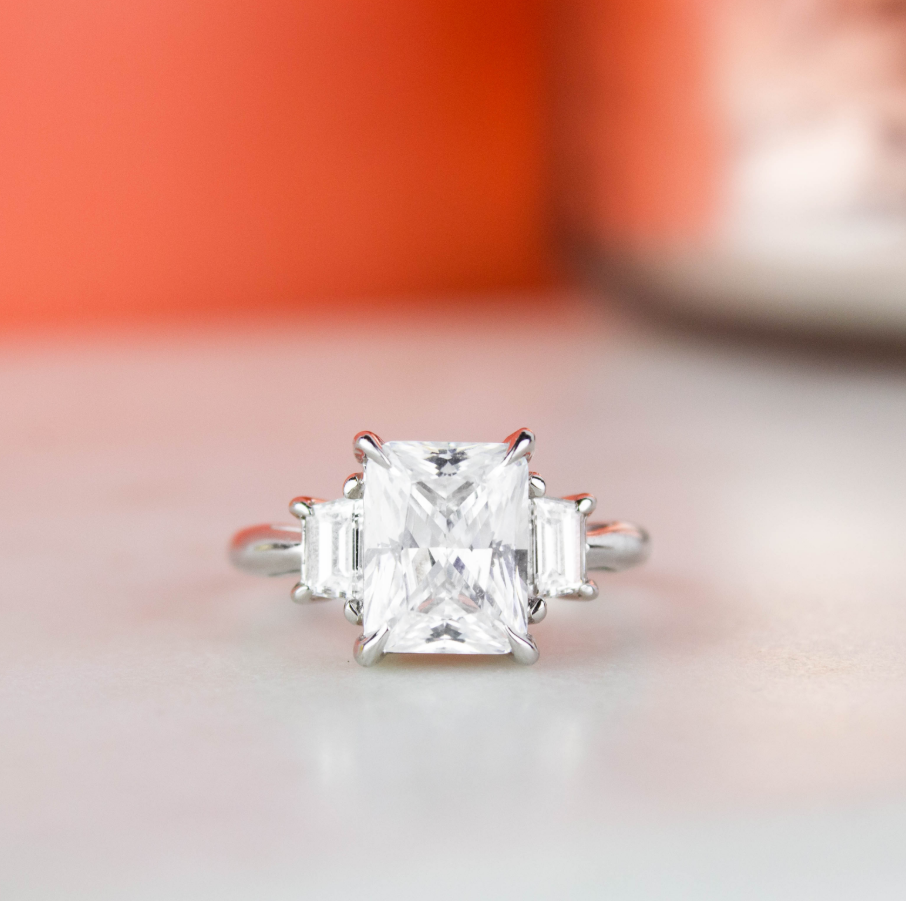

This means you can find radiant cut engagement rings with 2 carats at better prices than a round brilliant. These rings lengthen the finger and cost less than rounds. The outline of radiant cut engagement rings is similar to an emerald-cut diamond, but it has much more brilliance. A ratio of 1.00-1.03 is recommended for a square-shaped radiant cut. The optimal ratio for rectangular radiant cut engagement rings is 1.25, but any value between 1.20 and 1.30 will do.


Once you've decided on a square or rectangular shape, make sure the proportions are correct. When choosing a radiant ring, look for well-centered cullet, parallel sides, and equal-sized corners. The trimmed or smooth corners of a radiant-cut diamond set it apart from the competition. Radiant-cut diamonds have princess-cut facets but are often rectangular in shape, similar to an emerald cut. This fancy cut diamond has subsequently become the center stone for many celebrity engagement rings. In addition, the radiant cut's corners are beveled (rather than sharp), making the diamond more resilient and less likely to crack. He aimed to combine the timelessness of a square silhouette with the brilliance and fire of a round cut.Ī radiant stone is cut with 70 facets and is available in square and rectangular shapes. Master diamond cutter Henry Grossbard invented the radiant cut ring in 1977. A radiant engagement ring’s square silhouette and sparkling facets render it an unforgettable center stone. Whether you’re hunting down a chunky classic for a Prohibition-themed cocktail party or seeking a clean contemporary design to complement your casual ensemble, find an exquisite collection of antique, new and vintage rings on 1stDibs.Radiant cut engagement rings have become modern masterpieces due to their chic square form and softly trimmed corners. Art Deco jewelry, on the other hand, which originated during the 1920s and ’30s, is by and large “white jewelry.” White metals, primarily platinum, were favored over yellow gold in the design of antique Art Deco rings and other accessories as well as geometric motifs, with women drawn to the era’s dazzling cocktail rings in particular. Antique Art Nouveau rings might feature depictions of winged insects and fauna as well as women, who were simultaneously eroticized and romanticized, frequently with long flowing hair. The Art Nouveau movement (1880–1910) brought with it rings inspired by the natural world. The late-1700s paste jewelry was a predecessor to what we now call fashion or costume jewelry. Pearls, along with colored gemstones like garnets, rubies and sapphires, were widely used in Georgian jewelry. Named for the monarchies of the four King Georges, who in succession ruled England starting in 1714 (plus King William’s reign), antique Georgian rings, be they engagement rings or otherwise, are also coveted by collectors. The most collectible engagement rings are those from the Victorian, Edwardian and Art Deco eras. Designs for Victorian-era engagement rings often featured repoussé work and chasing, in which patterns are hammered into the metal.Įngagement rings, which are reliably intimidating to shop for, are still widely recognized as symbols of love and commitment.

Jewelry devotees have long pined for rings adorned with reptiles, thanks to antique Victorian rings - well, specifically, Queen Victoria’s illustrious engagement ring, which took the form of a gold snake set with rubies, diamonds and an emerald (her birthstone). The serpent is now a popular motif in fine jewelry. Italian luxury jewelry house Bvlgari has become famous for its widely loved Serpenti motif, for example, and its Serpenti ring, like the other accessories in the collection, began as an homage to jewelry of the Roman and Hellenistic eras. Over time, rings have frequently taken the form of serpents, which have long been associated with eternal life, health and renewal. Rings have also forever been emblematic of eternity. They’ve carried deep meaning since at least the Middle Ages, when diamond rings symbolized strength and other kinds of rings were worn to signify romantic feelings or to denote an affiliation with a religious order. No matter their origin or specific characteristics, rings are timeless, versatile accessories. Antique and vintage rings have long held a special place in the hearts of fine jewelry lovers all over the world.


 0 kommentar(er)
0 kommentar(er)
